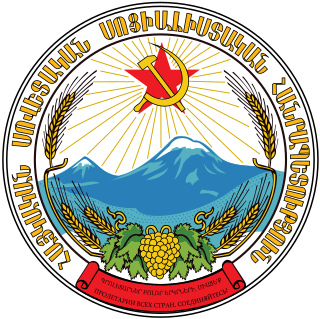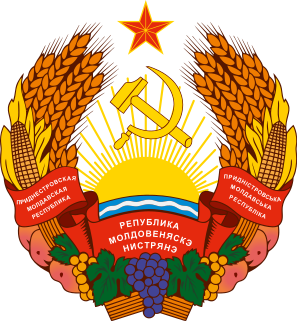 W
WThe emblem of the Armenian SSR was devised from an initial prototype sketch by Martiros Saryan, a famous Armenian painter, and was adopted in 1937 by the government of the Armenian SSR.
 W
WThe emblem of the Republic of Artsakh consists of an eagle above which is an ornamented crown. On the chest of the eagle is a shield with a panorama of a mountain range and under it a vertically set Flag of Artsakh. Over this are the two stone heads of "Granny and Gramps" from the We Are Our Mountains monument in Stepanakert, the capital of Artsakh. The eagle's feet clutch various agricultural products including wheat and grapes. The outer rim is made up of a golden circular ribbon bearing inscription "Լեռնային Ղարաբաղի Հանրապետություն-Արցախ" in Armenian.
 W
WThe Great Seal of the State of California was adopted at the California state Constitutional Convention of 1849 and has undergone minor design changes since then, the last being the standardization of the seal in 1937. The seal shows the Roman goddess Minerva, the goddess of wisdom and war, because she was born an adult, and California was never a territory; a California grizzly bear feeding on grape vines, representing California's wine production; a sheaf of grain, representing agriculture; a miner, representing the California Gold Rush and the mining industry; and sailing ships, representing the state's economic power. The word Eureka, meaning "I have found it", is the California state motto.
 W
WThe coat of arms of Connecticut is an official emblem of the state of Connecticut, alongside the seal and state flag. The General Assembly of Connecticut adopted a design for the official arms of the state on March 24, 1931, which it ordered to be drawn and filed with the Secretary of the State.
 W
WCoat of arms of New Holland, resulting of the union of the four coats of the main Dutch dominions in Northeastern Brazil: The first quarter represents Pernambuco; the second quarter, on the right, Itamaracá; below, on the left, Paraíba and finally Rio Grande do Norte.
 W
WThe national emblem of the Abkhaz Autonomous Soviet Socialist Republic was adopted in 1937 by the government of the Abkhaz Autonomous Soviet Socialist Republic. The emblem is identical to the emblem of the Georgian Soviet Socialist Republic.
 W
WThe national emblem of the Adjar Autonomous Soviet Socialist Republic was adopted in 1922 by the government of the Adjar Autonomous Soviet Socialist Republic. The emblem is identical to the emblem of the Georgian Soviet Socialist Republic.
 W
WThe coat of arms of the Georgian Soviet Socialist Republic was adopted on May 20, 1921 by the government of the Georgian Soviet Socialist Republic. The coat of arms is loosely based on the coat of arms of the Soviet Union. It shows symbols of agriculture. The red star rising above the Caucasus stands for the future of the Georgian nation, and the hammer and sickle for the victory of Communism and the "world-wide socialist community of states".
 W
WThe official description of the Coat of arms of Kutaisi is so:
 W
WThe Seal of the City of Los Angeles is, since 1905, the official seal of the City of Los Angeles, a city located in the southern portion of the U.S. state of California.
 W
WThe coat of arms of Miskolc, Hungary was created in 1909 based on the mediaeval seals of the city.
 W
WThe coat of arms of the Moldavian Soviet Socialist Republic was adopted on February 10, 1941 by the government of the Moldavian Soviet Socialist Republic. The coat of arms is based on the coat of arms of the Soviet Union. It shows symbols of agriculture, an outer rim featuring wheat, corn, grapes and clover. The red banner bears the Soviet Union state motto in both the Russian and Moldovan languages. In Moldovan, it was initially "Пролетарь дин тоате цэриле, униць-вэ!", then, from the 1950s "Пролетарь дин тоате цэриле, уници-вэ!", both transliterated as "Proletari din toate țările, uniți-vă!". The acronym "MSSR" is shown only in Moldovan ("РССМ").
 W
WThe Emblem of the Transcaucasian SFSR was adopted by the government of the Transcaucasian SFSR. The final version was adopted in 1930.
 W
WThe coat of arms of Transnistria constitutes a remodeled version of the former Moldavian Soviet Socialist Republic emblem, as substituted by the internationally recognized Moldovan government after the dissolution of the Soviet Union in 1991. The only major pictorial change made in the Transnistrian version involves the addition of waves, representing the River Dniester. However, the inscriptions on the banner were changed: unlike the Moldavian SSR emblem, which bore the acronym РССМ and the USSR state slogan "Workers of the world, unite!" in the Russian and Moldavian languages, the Transnistrian emblem bears the name Pridnestrovian Moldavian Republic in the Romanian, Russian and Ukrainian languages. In the Moldovan Cyrillic version of Romanian, it reads "Република Молдовеняскэ Нистрянэ" ; in Russian, it reads "Приднестровская Молдавская Республика" ; and, in Ukrainian, it reads "Придністровська Молдавська Республіка". Despite the emblem's depiction of the hammer and sickle, Transnistria is not a socialist state.
 W
WThe Emblem of the Turkmen Soviet Socialist Republic was adopted on 2 March 1937 by the government of the Turkmen Soviet Socialist Republic. The coat of arms is based on the coat of arms of the Soviet Union. It shows symbols of agriculture and heavy industry, as well as a symbol of the Turkmen people, a rug. The rising Sun stands for the future of the Turkmen nation, the red star as well as the hammer and sickle for the victory of Communism and the "world-wide socialist community of states".
 W
WThe coat of arms of the Western Cape is the official heraldic symbol of the Western Cape province of the Republic of South Africa. It has been in use since 1998.